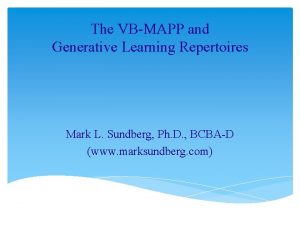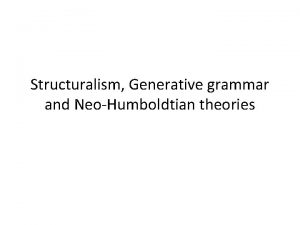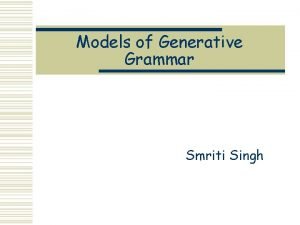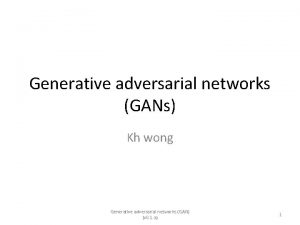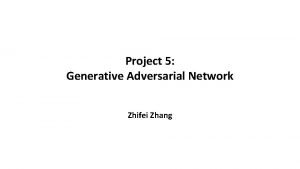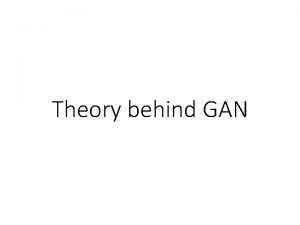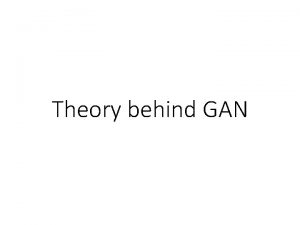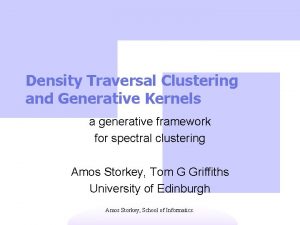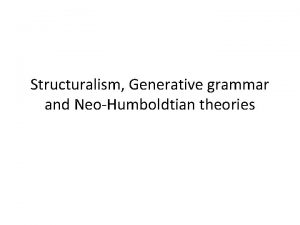Image recognition Defense adversarial attacks using Generative Adversarial

























- Slides: 25

Image recognition: Defense adversarial attacks using Generative Adversarial Network (GAN) Speaker: Guofei Pang Division of Applied Mathematics Brown University Presentation after reading the paper: Ilyas, Andrew, et al. "The Robust Manifold Defense: Adversarial Training using Generative Models. " ar. Xiv preprint ar. Xiv: 1712. 09196 (2017).

Outline § Adversarial attacks § Generative Adversarial Network (GAN) § How to defense attacks using GAN § Numerical results 2/25

Adversarial Attacks 3/25

Adversarial Attacks 4/25

Adversarial Attacks n = m n*m 5/25

Adversarial Attacks Adversarial examples for a classifier C(): § A pair of input x 1 and x 2 § A person says they are of the same class § But a classifier will they are completely different! 6/25

Adversarial Attacks Why does classifier become fool for these examples? 7/25

Adversarial Attacks Why does classifier become fool for these examples? An intuition from the authors: § Natural image: Low-dimensional manifold § Noisy image: High-dimensional manifold § High dimensionality is tough for classifier. 8/25

Generative adversarial network (GAN) § x and x’ have similar PDF § G() has learned the underlying distribution of image dataset after training GAN § The DNN G() is a nonlinear mapping from lowdimensional space, z, to high-dimensional space, x’ Original image x GAN Synthetic image /Generative model x’=G(z) Generator G(z) Noisy input z, say, z – N(0, I) 9/25

Generative adversarial network (GAN) § Convergence state: pdata(x)=p. G(x) § Green solid line: probability density function (PDF) of the generator G() § Black dotted line: PDF of original image x, i. e. , pdata(x) § Blue dash line: PDF of discriminator D() 10/25

Generative adversarial network (GAN) 11/25

How to defense attacks using GAN § G() is pre-trained and has learned the underlying distribution of the training (image) dataset after training GAN Synthetic image x’=G(z*) (Preserve low-dimensional manifold) Invert and Classify Classifier C() Original image x (Could include highdimensional manifold when noise enters) 12/25

How to defense attacks using GAN § G() is pre-trained and has learned the underlying distribution of the training (image) dataset after training GAN Enhanced Invert and Classify Synthetic image x’=G(z*) (Preserve low-dimensional manifold) Upper bound of attack magnitude Classifier C() (retrain the classifier) Classification loss 13/25

Numerical results First-order classifier attacks for handwritten digit classification 14/25

Numerical results First-order classifier attacks for handwritten digit classification 15/25

Numerical results First-order classifier attacks for handwritten digit classification 16/25

Numerical results First-order classifier attacks for gender classification 17/25

Numerical results First-order classifier attacks for gender classification 18/25

Numerical results Substitute model attacks Results from Invert and Classify 19/25

Numerical results Comparison between Invert and Classify and Enhanced Invert and Classify 20/25

Numerical results 21/25

Numerical results 22/25

Numerical results 23/25

Numerical results 24/25

Thinking § GAN for regression problems? § GAN versus other neural networks? § One defense strategy for all types of attacks? 25/25
 Quantum generative adversarial learning
Quantum generative adversarial learning Singing
Singing Spectral normalization
Spectral normalization Generative adversarial networks
Generative adversarial networks Melody randford
Melody randford On adaptive attacks to adversarial example defenses
On adaptive attacks to adversarial example defenses Th and tc cells
Th and tc cells Search for an image using an image
Search for an image using an image Exploring self attention for image recognition
Exploring self attention for image recognition He kaiming
He kaiming Text recognition image
Text recognition image Text recognition image
Text recognition image Analogizers
Analogizers Dynamic image networks for action recognition
Dynamic image networks for action recognition The recognition of human movement using temporal templates
The recognition of human movement using temporal templates Hand gesture recognition project using arduino
Hand gesture recognition project using arduino Shape matching and object recognition using shape contexts
Shape matching and object recognition using shape contexts Fingerprint recognition using matlab project
Fingerprint recognition using matlab project Bolongie
Bolongie Vbmapp
Vbmapp Structuralism grammar
Structuralism grammar Phrase structure rules
Phrase structure rules Ontologisk realisme
Ontologisk realisme Generative recursion
Generative recursion Deep and surface structure in linguistics
Deep and surface structure in linguistics Bentley generative components
Bentley generative components



















